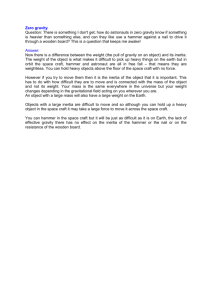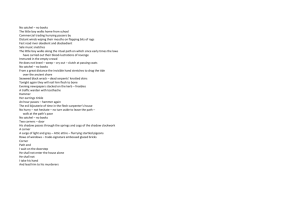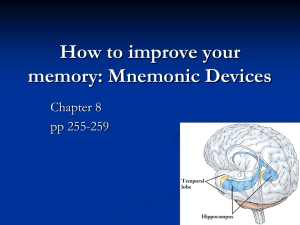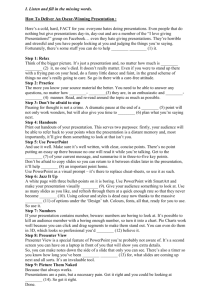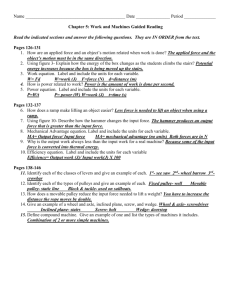TOOLBOX OF FAITH A Tapestry of Faith Program for Children
advertisement
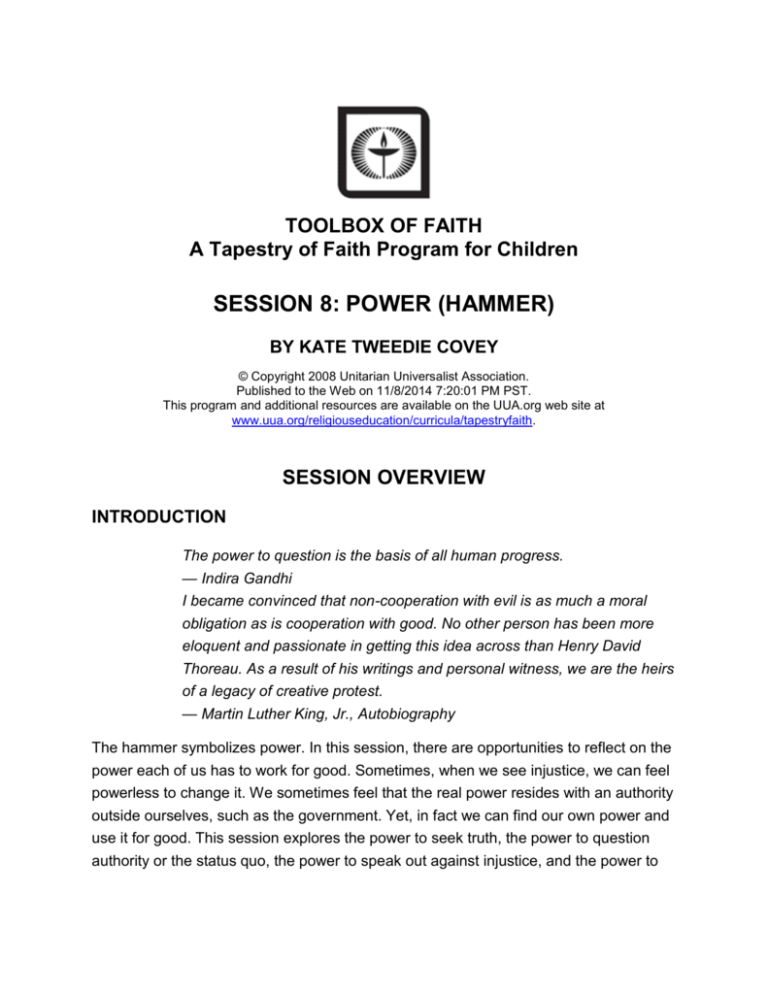
TOOLBOX OF FAITH A Tapestry of Faith Program for Children SESSION 8: POWER (HAMMER) BY KATE TWEEDIE COVEY © Copyright 2008 Unitarian Universalist Association. Published to the Web on 11/8/2014 7:20:01 PM PST. This program and additional resources are available on the UUA.org web site at www.uua.org/religiouseducation/curricula/tapestryfaith. SESSION OVERVIEW INTRODUCTION The power to question is the basis of all human progress. — Indira Gandhi I became convinced that non-cooperation with evil is as much a moral obligation as is cooperation with good. No other person has been more eloquent and passionate in getting this idea across than Henry David Thoreau. As a result of his writings and personal witness, we are the heirs of a legacy of creative protest. — Martin Luther King, Jr., Autobiography The hammer symbolizes power. In this session, there are opportunities to reflect on the power each of us has to work for good. Sometimes, when we see injustice, we can feel powerless to change it. We sometimes feel that the real power resides with an authority outside ourselves, such as the government. Yet, in fact we can find our own power and use it for good. This session explores the power to seek truth, the power to question authority or the status quo, the power to speak out against injustice, and the power to band together with others who share our values and goals to make a difference for what is good and just. In leading this session, emphasize that power can be used for good or for evil. In addition, emphasize the distinction between strength and power. Allow time for participants to engage with the idea of civil disobedience as a strategy to protest a law that is unjust. GOALS This session will: Help deepen Unitarian Universalist identity, ethical discernment, and understanding of Unitarian Universalist faith through reflection and discussion Teach participants that Unitarian Universalism is a faith that will help you learn about the power you have and help you decide how to use your power for good Demonstrate that Unitarian Universalism values the right of conscience and the use of the democratic process within our congregations and in society at large (fifth Principle) Teach that Unitarian Universalism affirms that we are part of an interdependent web of all life (seventh Principle), and that when one part of the web suffers injustice, the entire web suffers injustice Engage participants in the spiritual practices of chalice lighting, voicing of joys and concerns, and intentional discussion LEARNING OBJECTIVES Participants will: Connect the symbol of a hammer with the power for good Hear a story about a Unitarian minister and a community of abolitionists who used their power to question government authority and defy the Fugitive Slave Law, contributing to the anti-slavery cause Experience power and strength in a variety of games Learn a song that uses the hammer as a metaphor for an individual's power to fight injustice Reflect on the implications of using power, and how it can be used for good or for bad SESSION-AT-A-GLANCE ACTIVITY MINUTES Welcoming and Entering Opening 5 Activity 1: Feel the Power 5 Activity 2: Story — Theodore Parker and the Fugitive Slaves: Refusing to Follow an Unjust Law 10 Activity 3: Active Games of Strength and Power 15 Activity 4: Singing "If I Had a Hammer" 10 Activity 5: Council Circle 15 Faith in Action: Ideas Alternate Activity 1: Word Art — "If I Had a Hammer" 25 SPIRITUAL PREPARATION Take a moment and let your body and mind settle. If you are comfortable doing so, spend a few moments in peaceful meditation. Consider this session's story, "Theodore Parker and the Fugitive Slaves: Refusing to Follow an Unjust Law." Reflect on how you would answer the questions you will pose to the children in Council Circle: Do you think there are times when it is right to use violence to fight against injustice? How do you think you would have reacted to the Fugitive Slave Act if you had lived in Boston in the 1850s? If you were a white? If you were a free black? Throughout the history of the United States, questioning authority and civil disobedience have played significant roles in many reforms that we take for granted today — laws that guarantee civil rights, votes for women, and the power of labor unions, among others. How do you think we should teach children when it is right to question authority and when it is important to follow the rules? SESSION PLAN WELCOMING AND ENTERING Materials for Activity A hammer A few slender nails A sheet of paper large enough for tracing the outline of a hammer A pencil, color markers, clear tape, and a pair of scissors Optional: Toolbox of Our Faith poster Preparation for Activity Set out the materials on a worktable. Description of Activity This activity is intended for the time before the session, when participants arrive individually over a period of time — that is, "straggle in." As children arrive, invite them to work together to trace the outline of the hammer on the sheet of paper, Ask them to cut out the hammer shape and write "Power" on it. Suggest they use the nails to form some of the letters in "Power" by taping the nails onto the hammer shape. If the children finish before the session begins, you may invite them to add the hammer, symbolizing power as a tool of our faith, to the Toolbox of Our Faith poster. OPENING (5 MINUTES) Materials for Activity Chalice and candle or LED/battery-operated candle Lighter and extinguisher, if needed Newsprint, markers, and tape Tool of the Day — a hammer Preparation for Activity Print the opening words on newsprint. Post the newsprint where the children will be able to see it when they gather in your Council Circle space. Description of Activity Invite the children to gather in a circle in the Council Circle space. Light the chalice. Indicate where the opening words are posted for any children who are unfamiliar with them. Lead the group in reciting: We are Unitarian Universalists with minds that think, hearts that love, and hands that are ready to serve. Hold up the hammer. Tell the children it is the Tool of the Day. Ask, "What do you think makes this a Unitarian Universalist tool?" Allow participants to share ideas. Affirm that there is truly no one answer. Then offer the explanation that the hammer can represent power. You might say: Unitarian Universalism is a faith that values using our power to work for good. Unitarian Universalists support the importance of questioning as part of the democratic process. This is a key part of growing in faith and deepening in religious understanding. Unitarian Universalism values the right of conscience and the use of the democratic process within our congregations and in society at large, as our fifth Unitarian Universalist Principle states. Another Unitarian Universalist Principle, the seventh, affirms that we are part of an interdependent web of all life. When one part of that web suffers injustice, the entire web suffers injustice. That is another reason we believe we should use our power for good. Pass the hammer around the circle. Invite the children to share their experiences seeing or using hammers. Collect the hammer. Extinguish the chalice. ACTIVITY 1: FEEL THE POWER (5 MINUTES) Materials for Activity Hammers, enough for all participants, if possible Nails of different lengths and materials, at least four nails for each participant Lengths of scrap wood, thick enough to accept the longest nails you have brought, at least one piece for every two participants Large sheet of paper, a marker, scissors, clear tape, and the Toolbox of Our Faith poster Preparation for Activity This activity will be loud. Decide whether you want to bring the group outside, or identify a room where you will not disturb others in the building. Description of Activity To help participants become familiar with using the power of a hammer efficiently and safely, invite them to practice pounding nails into wood. Suggest they try a variety of ways of hammering, free form, at first. Often those inexperienced with using a hammer will hold one close to the head and use their wrist to pound. Teach the group the way that carpenters use hammers to get the best and most efficient effect from the power of the hammer and the power of the arm: Hold the hammer at the end of the handle to take advantage of the hammer head's weight when you strike the nail. By holding at the furthest end from the hammer head, the hammer becomes a lever, which gives it — and you — more power. Invite participants to feel the difference between hammering by holding the hammer close to the hammer head, and then holding the hammer farther down the handle. Offer these suggestions: Swing your entire arm from the shoulder instead of just using the wrist, to make your body more efficient. Feel the power! Pound a nail with a few taps to hold it upright. Then swing the hammer, letting the weight of the hammer drop onto the nail head from a distance. (This technique keeps thumbs safely out of the way, too!) ACTIVITY 2: STORY — THEODORE PARKER AND THE FUGITIVE SLAVES: REFUSING TO FOLLOW AN UNJUST LAW (10 MINUTES) Materials for Activity A copy of the story, "Theodore Parker and the Fugitive Slaves: Refusing to Follow an Unjust Law (included in this document) " Preparation for Activity Prepare to read the story or tell it dramatically. You may wish to engage a few participants to give voice to the roles of Theodore Parker and Millard Fillmore, both of whose written words are quoted in the story. Description of Activity Participants will hear about a time when a Unitarian minister used his power for good. By questioning the authority of the government — in particular, its enforcement of the Fugitive Slave Law — Theodore Parker aided the anti-slavery cause. The story presents, too, the way President Millard Fillmore — also a Unitarian, personally opposed to slavery — chose to use his power. Gather participants in a comfortable configuration for listening to a story. To introduce the story, you might say: This is a true story that happened in the 1850s, before the U.S. Civil War. At that time, treating some people as property — slaves — was still the official policy of the U.S. government. As the story of Ellen and William Craft unfolds, you will see how a Unitarian minister, Theodore Parker used his power to question authority. Read or tell the story. After the story, invite participants to briefly share their reflections and initial thoughts. Tell them they will discuss the story in more depth in Council Circle. ACTIVITY 3: ACTIVE GAMES OF STRENGTH AND POWER (15 MINUTES) Materials for Activity For Pyramid. Optional: Tumbling mats For Carry the Load. Two markers, such as orange rubber cones, or masking tape to make two finish lines Preparation for Activity Review the three games offered: Fugitives (Sardines), Pyramid, and Carry the Load. Decide which to include based on the amount of time you have, your meeting space, and the children in the group. For Fugitives. This game is based on a version of "hide and seek" that is also known as Sardines. It works best in a space that has multiple options for hiding spaces that will conceal several children together. For Pyramid. Find an open space, preferably carpeted. You may wish to lay out tumbling mats to protect children who may fall. For Carry the Load. You will need an open space where you can mark a start line and a finish line, about 30 feet apart. Place markers or lay down masking tape to indicate the two lines. Description of Activity Participants will physically experience power and strength in a variety of games. Fugitives (Sardines) Rename this popular version of "hide and seek" to reflect the fugitive slave experience. The goal of this game is similar to "hide and seek," except that the person who is "It" hides first. Everyone else then tries to find "It." When someone finds "It," they hide with "It" in the same spot. The game ends when everyone finds the hiding spot of "It." Children will experience the "safety in numbers" which escaped slaves may have felt upon reaching a community of abolitionists and free blacks in the North. They may also experience a feeling of powerlessness; as the hiders become increasingly conspicuous, the larger their group gets. Pyramid This game illustrates the power of cooperating together and gives each child a chance to experience how his/her own strength contributes to a group endeavor. Tell the group you will ask them to work together to make a human pyramid, but first they need some safety guidelines: Keep your arms and legs vertical to give your body and the pyramid for maximum support. Communicate with each other. Give the group a safety word, such as "STOP." Tell the children that if anyone is in pain or becomes afraid, they may call out the safety word, and the others will immediately dismantle the pyramid. Form teams of six to eight people or challenge the whole group to build a three-level human pyramid. Carry the Load Use this game to illustrate that sometimes power means using the strongest and weakest together in a strategy. Create teams of six to eight players. If the group has a dozen or fewer participants, allow them to work as a single team. The object of the game is for a team to move all of its players from one area to the other, under the following rules: To get to the other area, players must be carried. The player who carries a person across must be the next player carried across. You may use more than one player to carry another, but then the group will need to make sure this "team" of children are the next ones carried. Expect to make a new rule, on the fly, to address such a situation; with participants' help. The last player gets a free pass across, but only one player. If a team gets stuck or the players agree they have made a mistake, they may start over. If a player touches the ground, in any way, he/she must go back. You may like to warn the group that sometimes larger, stronger children may be inclined to just grab someone and go, but then they may find themselves stuck for a "ride." Or, you may prefer to let the participants find this out for themselves. If a team succeeds at this challenge, issue the next challenge: They must try it again, but this time no player can carry the same person he/she carried when the team was successful. In addition, if anyone being carried touches the ground, the team must begin again. Let participants be creative in how they carry each other, but stress safety, and watch for dangerous moves. Including All Participants If the group includes movement-challenged participants, adapt these games to create an active role for everyone. For Carry the Load, add a rule which enables a child who uses a wheelchair to contribute to a team solution, but which does not require other children to carry the child together with his/her wheelchair. Some children may be willing and able to have peers carry them from their wheelchair to another chair. However, check with a parent as well as the child, before initiating something like this. ACTIVITY 4: SINGING "IF I HAD A HAMMER" (10 MINUTES) Materials for Activity A copy of Leader Resource 1, "If I Had a Hammer (included in this document) " lyrics Preparation for Activity Listen to a recording of the song, "If I Had a Hammer," to make sure you know the tune. The YouTube website has vignettes of several performances of the song (at www.youtube.com/watch?v=r5dTlg2cyls). If you are not comfortable singing or leading a song, invite a volunteer from your congregation to lead the singing and/or provide musical accompaniment. Optional: Write the first verse of the song's lyrics on newsprint and post. You may wish to underline the words that change from verse to verse. Description of Activity Participants will learn a song in which the hammer is used as a metaphor for justice. Gather the group in a circle. Introduce the song, in these words or your own: This song is called "If I Had a Hammer." It was written by Pete Seeger, a Unitarian, with Lee Hays, when they were musicians in a group called The Weavers, in the 1950s. Many other musicians and people who gather to demonstrate against injustice continue to sing this song. You may be able to lead the group in singing the song straight through the first time, especially if you have posted the lyrics. Once the group can sing it comfortably, encourage them to feel its power as they sing it together again. ACTIVITY 5: COUNCIL CIRCLE (10 MINUTES) Materials for Activity Tool of the Day — a hammer Chalice and candle Safety matches and long fireplace matches Small dish for spent matches Candle snuffer Council candles (a tea light or votive candle for each participant, or some to share if group is very large) One tea light or votive candle of a different color Tray to hold council candles (preferably lined with sand) Woolen or other nonflammable blanket for smothering flames in case of emergency Optional: Glass bowl, water, and polished pebbles (for all participants, plus one extra) for alternative to council candles in tray Optional: Newsprint, markers, and tape Optional: A copy of the Unitarian Universalist hymnbook, Singing the Living Tradition Optional: Toolbox of Our Faith poster, a picture of the Tool of the Day, a marker, and tape or glue Preparation for Activity Choose closing song(s), chant(s), or reading(s) from options provided under "Description of Activity" or from those regularly used in your congregation. As needed, write the words on newsprint and post. Co-leaders may wish to use the same closing ritual for each Toolbox of Faith session. Customize, print out, and photocopy the Taking It Home section for all participants. Prepare the chalice and lighter or matches for the Reflection. Prepare the tray of council candles, matches, safety measures, etc. for the Sharing of Joys and Concerns. Place items you will need in the center of the Council Circle. Decide how to introduce fire safety and emergency procedures to the group. Have needed safety materials nearby. Optional: Instead of using a tray of council candles for sharing, you can fill a glass bowl with water. Place polished pebbles next to the bowl. Ask children to come and drop a pebble in the water as they share. Or, you can have a floating council candle tray. Use a large glass vessel filled with water to hold floating tea lights or votive candles. If you have not already made one, you will need to trace a picture of a hammer. Description of Activity Each session closes with a Council Circle. The goal of the Council Circle is to share our stories, listen to each other, and grow in faith together. Listening to each other is a religious act. The Council Circle includes three rituals: Reflection, Sharing of Joys and Concerns, and a Closing. Reflection Gather the group in the Council Circle. Light the chalice. Offer words spoken routinely in your congregational worship, or these: We are Unitarian Universalists with minds that think, hearts that love and hands that are ready to serve. Invite participants to reflect on what it means to use one's power for good, as they pass the Tool of the Day as a talking stick. Offer the following questions: When are some times when you have used your power to do good? When are some times when you could have, but did not? Why? You may say: Questioning authority is part of the democratic process. Sometimes, people break laws in order to prove that the laws are unjust. This is called "civil disobedience." When people decide to break a law that they consider immoral and unjust, they also choose to take the consequences for breaking the law. Taking the consequences — such as arrest and even jail — is part of the ethical use of civil disobedience. An example of civil disobedience is stepping into the yard of a nuclear power plant to protest nuclear power, knowing you will be arrested. When many people choose to be arrested for a cause, the injustice receives attention in the news media, and it causes others to join the fight, or at least to think about the issues, and ultimately change laws or practices. Throughout the history of the United States, questioning authority and civil disobedience have helped bring about change and make laws more just. Some examples are laws that protect civil rights, including voting rights, and laws that give working people a bigger say about their jobs by empowering labor unions. Ask the group: Do you think there are times when it is right to use violence to fight against injustice? Why or why not? If you lived in Boston in October of 1850, and you knew where the slave-catchers from Georgia could find Ellen and William Craft, what would you do? Would you act differently if you were white than if you were black? Would you act differently if you were a grown-up, or a child? Sharing of Joys and Concerns After discussion has closed, invite participants to share important things in their lives. What they share may or may not be related to the session topic and discussion. Invite participants to light a council candle from the chalice flame as they share. If there are not enough candles, it is OK to snuff out and re-light a candle. Save the candle of a different color for last. When all who want to share joys and concerns have done so, light this candle with the words, "For all the joys and concerns that remain unspoken." If you are using a glass bowl, water, and stones instead of council candles, invite participants to drop a stone into the bowl when they share. End the sharing by adding one last stone for unspoken joys and concerns. Closing Extinguish the council candles. You may extinguish the chalice now, or after your closing ritual. Close with an element (meditation, benediction, song) commonly used in your congregational worship, or use one or more of the suggestions below. Base your choice(s) on the needs and energy level of your group. With your co-leaders, you may elect to use the same ritual to close every session. A. Lead the group in singing "Meditation on Breathing," Hymn 1009 in Singing the Journey: A Hymnbook Supplement to Singing the Living Tradition. Hear the simple tune online (at www.uua.org/publications/singingjourney/52328.shtml). B. Have the group read in unison Reading 452 by Marjorie Montgomery in Singing the Living Tradition: Life is a gift for which we are grateful. We gather in community to celebrate the glories and mysteries of this great gift. C. Sing or say the words to "From You I Receive," Hymn 402 in Singing the Living Tradition. Teach the group the accompanying movements. From you I receive Scoop the air by reaching toward other participants, then bringing air toward yourself at chest level, that is, receiving it. To you I give Opposite from above — scoop the air at chest level and push it outward to "give" to other participants. Together we share All grasp hands. By this we live Make fist of strength with each hand and stack one hand on top of the other at belly button level. D. Go around the circle — using the Tool of the Day as a talking stick again, if you like — and invite each participant to say one thing they will do this week that relates to using one's power for good. A higher-energy version of the above could involve the group repeating back, chant-style, the statement of each participant, and adding, "Go out into the world and use your power!" E. Sing a familiar song. Suggestions: "Thula Klizeo," Hymn 1056 in Singing the Journey; "I Know This Rose Will Open," Hymn 396 in Singing the Living Tradition; or "Rejoice in Love," Hymn 380 in Singing the Living Tradition. F. Use this team spirit chant, "Pump It Up!" Leader: Pump, pump, pump it up! Group: Pump, pump, pump it up! Leader: Pump that UU spirit up! Group: Pump that UU spirit up! Instead of "Pump it up!" you may use "Fire it up!" or "Keep it up!" Pass the Tool of the Day around the circle and invite participants, one at a time, to voice a way they plan to use the quality of faith that was explored today. Guide them to say: With my UU [quality of faith, e.g., power], I will... Lead the group in responding to each participant's contribution: Group: Go, UU, go! If you have not yet done so, invite a participant to add a picture of a hammer and the word "Power" to the Toolbox of Our Faith poster. Or, tape a slender nail to the poster, and write the word "Power." Extinguish the chalice. Distribute Taking It Home handouts. Thank and dismiss participants. FAITH IN ACTION: IDEAS Description of Activity Lead the Congregation in Song Arrange for the children to lead the congregation in the song, "If I Had a Hammer," during a worship service or other gathering. Guide the children to prepare signs with the lyrics (see Alternate Activity 1: Word Art — "If I Had a Hammer"). The children can hold up the signs, so the congregation can join in. Invite a musical accompanist to support the group in song-leading. Demonstrate Collective Power Arrange for the group to join a local demonstration against injustice, such as a walk against hunger. In the Boston area, Project Bread sponsored the 40th Walk for Hunger (at www.projectbread.org) in May, 2008. The Food Bank of El Dorado County (at www.foodbankedc.org) (northeast California) runs an annual hunger walk in November. CROP (Communities Responding to Overcome Poverty) Walks (at www.churchworldservice.org/CROP/index.html) have been initiated in locations around the United States by the non-profit organization, Church World Service, a service ministry of 35 U.S. Protestant, Orthodox, and Anglican denominations. Find information online about CROP Walks in your area (at www.cropwalk.org/regional-office.html). LEADER REFLECTION AND PLANNING Reflect on these questions and discuss them with your co-leaders: How do we feel about today's session? What parts of the session worked well? What can we learn from the experience of this session? What preparations do we need to make for the next session? TAKING IT HOME The power to question is the basis of all human progress. — Indira Gandhi I became convinced that non-cooperation with evil is as much a moral obligation as is cooperation with good. No other person has been more eloquent and passionate in getting this idea across than Henry David Thoreau. As a result of his writings and personal witness, we are the heirs of a legacy of creative protest. — Martin Luther King, Jr., Autobiography IN TODAY'S SESSION... The hammer symbolizes power. In this session, children reflected on the power each of us has to work for good. We talked about times when people have used their power to question authority. Participants had time to engage the issues of civil disobedience when a law is unjust. We emphasized that power can be used for good or for ill. In addition, we emphasized the distinction between strength and power. We learned about power to illustrate that Unitarian Universalism is a faith that will help you identify the power you have and use it for good. We explored ways we can use our own power to live in affirmation of Unitarian Universalist Principles. Unitarian Universalism values the right of conscience and the use of the democratic process within our congregations and in society at large (fifth Principle). Unitarian Universalism affirms that we are part of an interdependent web (seventh Principle); when one part of that web suffers injustice, the entire web suffers injustice. EXPLORE THE TOPIC TOGETHER. Talk about... The children heard the story, "Theodore Parker and the Fugitive Slaves: Refusing to Follow an Unjust Law." The story describes the escape from the south of Ellen and William Craft, and their success in eluding capture by slave-catchers who came looking for them in Boston. Theodore Parker, a Unitarian minister, was a spokesperson for the fugitive slaves, along with free African Americans and white abolitionists who resisted enforcement of this federal law in the 1850s. The story also tells how President Millard Fillmore, also a Unitarian, upheld the Fugitive Slave Law in the hope of keeping the United States from a civil war. Throughout the history of the United States, the readiness of citizens to question authority and at times undertake civil disobedience has played a significant role in achieving reforms that we take for granted today — the legal protection of our civil rights, including our voting rights, and the formation of labor unions, among others. How do you think we should teach children when it is right to question authority and when it is important to follow the rules? As a family, you may want to explore these questions: Do you think there are times when it is right to use violence to fight against injustice? Why or why not? If you lived in Boston in October of 1850, and you knew where the slave-catchers from Georgia could find Ellen and William Craft, what would you do? Would you act differently if you were white than if you were black? Would you act differently if you were an adult than if you were a child? EXTEND THE TOPIC TOGETHER. Try... A FAMILY ADVENTURE Experience a demonstration or march against injustice, or join in a walk for justice, such as a CROP Walk. CROP (Communities Responding to Overcome Poverty) Walks (at www.churchworldservice.org/CROP/index.html) were initiated in locations around the United States by the non-profit organization, Church World Service, a service ministry of thirty-five U.S. Protestant, Orthodox, and Anglican denominations. A web page about the Newton, Massachusetts, CROP Walk describes it as "neighbors walking together to take a stand against hunger in our world. Together we raise awareness and funds for international relief and development, as well as local hunger-fighting." Find information online about CROP Walks in your area (at www.cropwalk.org/regional-office.html). FAMILY EXPLORATION Singing is a traditional hallmark of civil disobedience actions. Singing together helps demonstrators feel the power of their numbers. At a family campfire or at a family meal, sing together the song, "If I Had a Hammer." Learn and sing together other folk, traditional, and political songs. You may want to consult the book, Rise Up Singing, conceived, developed, and edited by Peter Blood and Annie Patterson (Bethlehem, PA: Sing Out Publications, 2004). ALTERNATE ACTIVITY 1: WORD ART — "IF I HAD A HAMMER" (25 MINUTES) Materials for Activity Large sheet(s) of poster board and markers A copy of Leader Resource 1, "If I Had a Hammer (included in this document) " lyrics Preparation for Activity Decide where you will display the poster of song lyrics, in your meeting space or elsewhere in the congregation. If you will have the group lead others in singing the song, "If I Had a Hammer" (Faith in Action), guide the children to write the lyrics large enough and legible enough to serve as a song-leading tool. Plan for small groups of participants to work on separate posters to display each verse. Description of Activity Invite participants to write the words to the song on a poster (or posters) and decorate it. Have participants add a border, illustrate the lyrics, and be creative in their portrayal of the song. TOOLBOX OF FAITH: SESSION 8: STORY: THEODORE PARKER AND THE FUGITIVE SLAVES: REFUSING TO FOLLOW AN UNJUST LAW Written by Polly Peterson. For a more interactive storytelling, assign a few participants to give voice to the words of Theodore Parker and Millard Fillmore, both of whose writings are quoted in the story. This is the story of Theodore Parker, a Unitarian minister who was determined to do whatever he could to end slavery in the United States. His powerful sermons were legendary. This is also the story of Millard Fillmore, whose actions earned him the contempt of Theodore Parker and abolitionists everywhere. He became the President of the United States in 1850. But the story begins with two runaway slaves, a married couple from Macon, Georgia, who planned a daring escape from slavery. Ellen Craft had skin so light that she could easily pass for white. She decided to disguise herself as an ailing Southern gentleman traveling to Philadelphia for medical care. Her husband, William Craft, whose skin was dark, would pretend to be the "master's" doting slave. Together they would travel 1000 miles to freedom in the North. On December 21, 1848, they both obtained passes to travel to the next town for Christmas. Instead of celebrating the holiday, however, they bought train tickets to Savannah, Georgia. From there, in their disguises, they traveled by train and steamboat up the coasts of South Carolina, North Carolina, Virginia, Washington, D.C., and Maryland. By Christmas Day, they had arrived in Philadelphia, a Northern city. After spending three weeks with a Quaker farmer and his family, the Crafts traveled to Boston, where they found a home. William worked as a cabinetmaker, and Ellen worked as a seamstress. They lived with Lewis Hayden, a free black, whose boarding house often served as a safe house for fugitive slaves on the Underground Railroad. The Crafts became members of Theodore Parker's Unitarian congregation. In September, 1850, the U.S. Congress passed the Fugitive Slave Law. The law not only provided for the return of fugitive slaves to their masters in the South, but also required private citizens in the North to assist in their capture. Abolitionists in Boston immediately began organizing resistance to the law. Theodore Parker was one of the founders of a Vigilance Committee, designed to protect "the colored inhabitants of Boston from any invasion of their rights." The Vigilance Committee included blacks as well as whites. Lewis Hayden and William Craft were members. On October 20, 1850, two agents arrived in Boston, sent by the Crafts' former owners to catch the fugitives. The agents took for granted that Boston officials would assist them, but in this they were disappointed. Vigilance Committee members protected the Crafts and relentlessly harassed the two slave-catchers. The coordinated actions of the abolitionist community and African Americans throughout the city thwarted the agents at every turn. The slave-catchers stayed in Boston for more than a month, trying to waylay the Crafts, but in the end, they had to return to Georgia empty-handed. The Crafts went hurriedly overseas to England, where they would be safe. Theodore Parker wrote an angry letter to President Fillmore, telling him the story of the Craft escape and challenging him to enforce his monstrous law. "Suppose I had taken the woman to my own house, and sheltered her there till the storm had passed by: should you think I did a thing worthy of fine and imprisonment?" he asked. He made it clear that he would obey the laws of God, even if it meant breaking the laws of men. Strange to say, Millard Fillmore, the President who had signed the Fugitive Slave Law, was also a Unitarian who hated slavery. How could his beliefs concerning the law be so different from Parker's? "God knows I detest slavery," he wrote to Daniel Webster, his secretary of state, "but . . . we must endure it and give it such protection as is guaranteed by the Constitution till we can get rid of it without destroying the last hope of free government in the world." President Fillmore had sworn to uphold the Constitution of the United States, and the Constitution allowed rights to slaveholders. He had promised to abide by the decisions of the Congress, and they had passed a Fugitive Slave Law. He threw the weight of his influence onto enforcing the Fugitive Slave Law because he believed it was the only way to keep the Union together, and he believed that safeguarding the Union was his sworn duty as President. Those who supported the Fugitive Slave Law often stated that the purpose of government was to protect property. They argued that, since slaves were property, no one, including the slaves themselves, had any right to deprive the slaveholder of rightful ownership. A runaway slave was nothing more than a thief, in this view. They also fooled themselves into believing all sorts of falsehoods about the natural inferiority of black people. Many even convinced themselves that black people were happier in slavery than they would be if left to fend for themselves in the world. Theodore Parker was incensed. How could the United States have strayed so far from the Revolutionary ideals of its founders? His own grandfather, Captain John Parker, had fought in Lexington, Massachusetts, in one of the very first skirmishes of the Revolutionary War. In those days, Americans had not been afraid to stand up for liberty, though it meant breaking the unjust laws imposed on them by their government in Britain. Now, this very country, founded on a principle of liberty and justice for all, was enforcing laws designed specifically to deny liberty and justice. "There hangs in my study . . . the gun my grandfather fought with at the battle of Lexington... and also the musket he captured from a British soldier on that day," Parker wrote in his letter to President Fillmore. "If I would not peril my property, my liberty, nay my life to keep my parishioners out of slavery, then I should throw away these trophies, and should think I was the son of some coward and not a brave man's child." Many other abolitionists were against using violence, but after the passage of the Fugitive Slave Law, Parker did not agree with them. He often used the proud history of the Revolution as a way of bringing people to his point of view. He also saw that over the years there had been a practice of erasing the memory of black participation in the Revolution, and he was dedicated to reminding his fellow Americans of the historic role blacks had played. Conflict between the northern and southern states was reaching a boiling point. Theodore Parker believed that the North must stand up against a government dominated by the interests of the Southern slaveholders. He hadn't wanted to put the abolition of slavery into the center of his life and ministry, but he felt he had no choice. Millard Fillmore hadn't wanted to support the institution of slavery, but he also felt he had no choice. He did not want his country to divide in two. In the end, Fillmore's signing of the Fugitive Slave Law probably did keep the country together for another ten years. And, in the end, that law probably strengthened the resolve of people in the North, making it possible for them to win the Civil War. Up to that point, it was easy for Northerners to see slavery as none of their business. Whether they hated slavery or not, few Northerners considered themselves personally responsible until they were forced to participate in the capture of fugitives and to witness the kidnapping of innocent free blacks by slave-catchers. Until the time of the Fugitive Slave Law, abolitionists had been very unpopular, even in Massachusetts. Now, Theodore Parker, who had been despised by many for his radical views, suddenly became enormously popular. Every week, his sermons and speeches were heard by thousands of people and read by many more. One person who read everything by Theodore Parker that he could get his hands on was William Herndon of Illinois, Abraham Lincoln's law partner. Herndon often passed along Parker's writings to Lincoln, who expressed his admiration for it. In one sermon, Herndon had underlined the following words that he thought would interest Lincoln: "Democracy is direct selfgovernment, over all the people, for all the people, by all the people." Ten years later, Abraham Lincoln became the President of the United States, and the Civil War began. By then, Theodore Parker had died. He did not live to see the abolition of slavery in the United States. Yet, he had helped to lay the groundwork by convincing many people that they must not blindly follow unjust laws. His words had the power to persuade many people to join the fight to end slavery. TOOLBOX OF FAITH: SESSION 8: LEADER RESOURCE 1: IF I HAD A HAMMER LYRICS The song, "If I Had a Hammer," was written by Pete Seeger and Lee Hays in the 1950s while they were members of the band, The Weavers, and popularized in the next decade when Peter, Paul, and Mary recorded and performed it. Permission pending from The Richmond Organization. If I had a hammer, I'd hammer in the morning I'd hammer in the evening, All over this land. I'd hammer out danger, I'd hammer out a warning, I'd hammer out love between my brothers and my sisters, All over this land. If I had a bell, I'd ring it in the morning, I'd ring it in the evening, All over this land I'd ring out danger, I'd ring out a warning I'd ring out love between my brothers and my sisters, All over this land. If I had a song, I'd sing it in the morning, I'd sing it in the evening, All over this land I'd sing out danger, I'd sing out a warning I'd sing out love between my brothers and my sisters, All over this land. Well I've got a hammer, And I've got a bell, And I've got a song to sing, all over this land. It's the hammer of justice, It's the bell of freedom, It's the song about love between my brothers and my sisters, All over this land. It's the hammer of justice, It's the bell of freedom, It's the song about love between my brothers and my sisters, All over this land. FIND OUT MORE Hear "If I Had a Hammer" The YouTube website has vignettes of several performances of the song (at www.youtube.com/watch?v=r5dTlg2cyls), "If I Had a Hammer." One video includes clips of performances by Peter, Paul, and Mary; Trini Lopez; the Mitch Miller Band; and Pete Seeger, who wrote the song with Lee Hays when they were members of The Weavers. Pete Seeger and Protest Music A rich resource for sing-along songs from folk and political traditions is Rise Up Singing, a spiral-bound resource book of song lyrics and guitar chords conceived, developed, and edited by Peter Blood and Annie Patterson (Bethlehem, PA: Sing Out Publications, 2004). Rent or purchase the DVD documentary, If I Had a Hammer: Pete Seeger and the American Quest for Justice (at www.samn.org/index.htm), produced by Tim Brachocki and available from the Syracuse Alternative Media Network (SAMN). From the SAMN website: Pete Seeger has been a singer and songwriter since 1939. He traveled the country performing with Woody Guthrie and together they became part of The Almanac Singers. In the early 1950s, Pete was a member of The Weavers and they had a number of national hit songs. Seeger was blacklisted and cited for Contempt of Congress by the House Committee on Un-American Activities for refusing to testify in 1955. The song, "If I had a Hammer," was written in support of progressive movements in 1949 and has since become known around the world. He was a vocal critic against the Vietnam War and his song "Where Have All the Flowers Gone?" has become a popular anti-war anthem... He has employed music throughout his life to entertain, educate, and organize people concerning issues of peace and social justice. Civil Disobedience Read a short introduction to the various movements for reform in our democracy. Visit the website of the Civil Liberties Monitoring Project, and read "The Role of Civil Disobedience in Democracy" (at www.civilliberties.org/sum98role.html) by Kayla Starr, adapted by Bonnie Blackberry. An essay by Peter Suber which originally appeared in Philosophy of Law: An Encyclopedia edited by Christopher B. Gray (Garland Pub. Co., 1999) may be read online: "About 'Civil Disobedience' by Henry David Thoreau, 1849." (at www.earlham.edu/~peters/writing/civ-dis.htm) Here is an excerpt from Suber's essay: While Walden can be applied to almost anyone's life, "Civil Disobedience" is like a venerated architectural landmark: it is preserved and admired, and sometimes visited, but for most of us there are not many occasions when it can actually be used. Still, although it is seldom mentioned without references to Gandhi and King, "Civil Disobedience" has more history than many suspect. In the 1940's it was read by the Danish resistance, in the 1950's it was cherished by people who opposed McCarthyism, in the 1960's it was influential in the struggle against South African apartheid, and in the 1970's it was discovered by a new generation of anti-war activists. The lesson learned from all this experience is that Thoreau's ideas really do work, just as he imagined they would.


